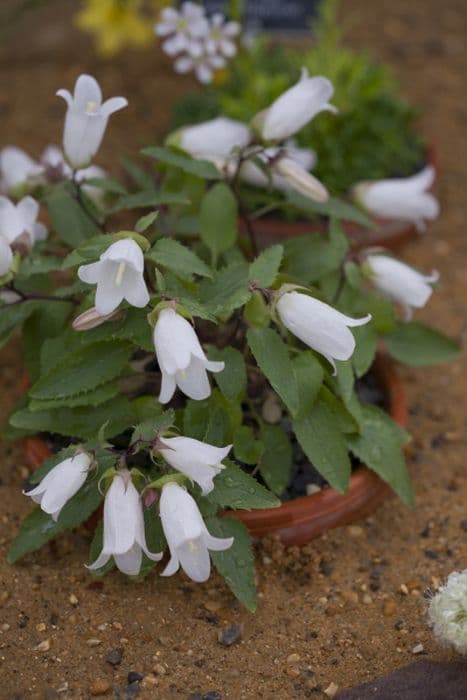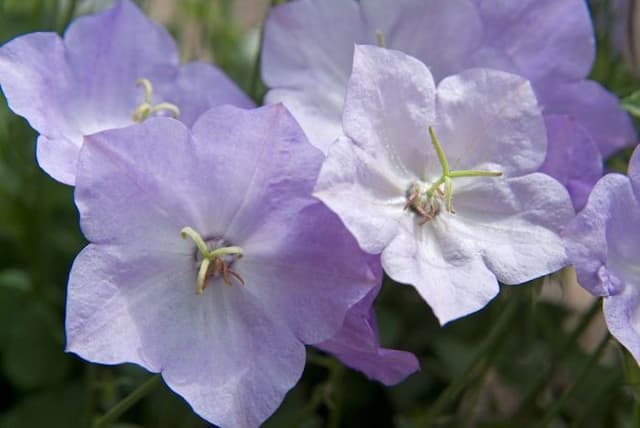Cardinal Flower Lobelia × speciosa Crimson Princess = 'Gencrim' (PBR) (Princess Series)
![lobelia [Crimson Princess]](/_next/image?url=https%3A%2F%2Fplants-admin.emdemapps.com%2Fimages%2Fplants%2F%2Fimages%2F604b62f9f0a26.png&w=3840&q=75)
ABOUT
The Lobelia Crimson Princess is a striking plant known for its vibrant and colorful blossoms. The flowers are a deep crimson hue, appearing somewhat like little trumpets that add a splash of royal elegance wherever they grow. The foliage provides a lush green backdrop for the intense red flowers, emphasizing their fiery color. The leaves themselves are rather narrow and pointed, with a slightly toothed edge, giving the plant a delicate and intricate texture. Each bloom has a slightly open lip at the front, which makes it particularly attractive to pollinators like hummingbirds and bees who are enticed by the nectar and vivid color display. The contrast between the red flowers and the green foliage is exceptionally eye-catching, and the plant tends to have a bushy, full appearance, overflowing with blossoms during its blooming period. The overall impression is of a vibrant, yet graceful plant that would add significant aesthetic value to any garden setting.
About this plant
 Names
NamesSynonyms
Crimson Princess Lobelia, Princess Lobelia.
Common names
Lobelia × speciosa 'Gencrim'
 Toxicity
ToxicityTo humans
The Lobelia plant has a level of toxicity to humans. If ingested, it can cause unpleasant symptoms including nausea, vomiting, diarrhea, coughing, dizziness, and a slackened heartbeat. In severe cases, it could potentially cause convulsions or more serious heart-related issues. It is advised to avoid consuming this plant and to keep it out of the reach of children due to its toxic nature.
To pets
The Lobelia plant is also toxic to pets. If animals ingest this plant, they may exhibit symptoms similar to those in humans, such as drooling, nausea, vomiting, diarrhea, abdominal pain, and a decreased heart rate. Severe cases can lead to more serious health complications including convulsions and cardiac anomalies. Pet owners should ensure that the plant is kept away from animals to prevent accidental ingestion.
 Characteristics
CharacteristicsLife cycle
Perennials
Foliage type
Deciduous
Color of leaves
Green
Flower color
Crimson
Height
2 feet (0.61 meters)
Spread
1 feet 6 inches (0.46 meters)
Plant type
Herb
Hardiness zones
6
Native area
North America
Benefits
 General Benefits
General Benefits- Attractive flowers: The plant showcases vibrant crimson flowers that add a splash of color to gardens and landscapes.
- Long blooming period: Lobelia x speciosa 'Crimson Princess' has a prolonged flowering season, offering visual interest for an extended time.
- Hummingbird attractor: The tubular flowers are known to attract hummingbirds, providing an opportunity to observe these lovely birds up close.
- Butterfly attractor: The brightly colored blooms also attract butterflies, supporting local biodiversity and pollinators.
- Low maintenance: This Lobelia variety is relatively easy to care for, requiring minimal attention once established in the right conditions.
- Drought tolerance: Once established, the plant has a moderate level of drought tolerance, reducing the need for frequent watering.
- Compact growth: The 'Crimson Princess' cultivar has a compact growth habit, making it suitable for smaller gardens or as a border plant.
- Versatility: It can be used in mixed perennial borders, container gardens, and as an accent plant, providing versatility in landscaping designs.
 Medical Properties
Medical PropertiesThis plant is not used for medical purposes.
 Air-purifying Qualities
Air-purifying QualitiesThis plant is not specifically known for air purifying qualities.
 Other Uses
Other Uses- Artistic Inspiration: The striking crimson color of the Princess Hybrid Lobelia can serve as a vivid subject for painters and photographers, letting them capture the beauty of the flower in various artistic mediums.
- Floral Language and Symbolism: In the language of flowers, Lobelia can symbolize distinction or malevolence, and thus can be used in floral arrangements to convey complex messages without words.
- Natural Fabric Dyes: The pigments from the Princess Hybrid Lobelia flowers might be used to create natural dyes for coloring fabrics, offering a range of hues from subtle reds to deep purples.
- Educational Tool: This Lobelia can be used in schools for educational purposes to teach children about hybridization, plant care, and the importance of pollinators in the ecosystem.
- Garden Photography: As a photogenic plant, the Princess Hybrid Lobelia can be used to enhance the visual appeal of gardening blogs, magazines, and social media posts.
- Companion Planting: When planted alongside vegetables, the Princess Hybrid Lobelia may help attract pollinators or potentially deter certain pests due to its intense color and fragrant nature.
- Themed Garden Design: The Princess Hybrid Lobelia's rich color and growth habit make it an ideal candidate for thematic garden designs, such as a "royal" or "princess" themed garden.
- Landscape Art: Landscape designers can use this variety of Lobelia to 'paint' with plants, creating large-scale outdoor installations that harness the plant's visual impact.
- Bee and Butterfly Gardens: The nectar-rich blooms of the Princess Hybrid Lobelia provide a valuable food source for bees, butterflies, and hummingbirds, enhancing biodiversity in the garden.
- Culinary Garnish: Although not typically consumed, the vibrant flowers can occasionally be used as a delicate, ornamental garnish for desserts and cocktails, as long as they are pesticide-free and confirmed safe for such use.
Interesting Facts
 Feng Shui
Feng ShuiThe Lobelia is not used in Feng Shui practice.
 Zodiac Sign Compitability
Zodiac Sign CompitabilityThe Lobelia is not used in astrology practice.
 Plant Symbolism
Plant Symbolism- Uniqueness: As Lobelia × speciosa 'Gencrim' is a hybrid, it often symbolizes uniqueness and the beauty of combining different elements to create something new and extraordinary.
- Attraction: The deep crimson color of the 'Crimson Princess' can represent deep attraction and passion, often used to signify a strong and irresistible allure.
- Vibrancy: The vivid hues of the 'Crimson Princess' speak to vibrancy and liveliness, suggesting an energetic and expressive personality or environment.
- Distinction: As part of the Princess Series, this plant may symbolize distinction and a regal bearing, highlighting refined beauty and exclusivity.
- Medical Healing: Lobelias are known for their historic use in medicine, thus they may represent healing and the relief of ailments.
 Water
WaterLobelia Crimson Princess should be watered deeply to ensure that the water reaches the roots, generally once or twice a week depending on the climate and soil conditions. During hot or dry periods, more frequent watering may be necessary, perhaps every two to three days. The goal is to maintain a consistently moist but well-drained soil environment, as standing water can lead to root rot. When watering, aim for about one to two gallons of water per plant, adjusting as needed for weather conditions. It is best to water early in the morning to reduce evaporation and avoid wetting the foliage too much to prevent disease.
 Light
LightThe Lobelia Crimson Princess thrives in full to partial sunlight. Ideally, the plant should receive at least four to six hours of direct sunlight daily. An optimal spot for this plant would be in a garden bed that gets plenty of morning sun and some afternoon shade, especially in hotter climates where the strong afternoon sun might be too intense.
 Temperature
TemperatureThe Lobelia Crimson Princess prefers moderate temperatures and does well in USDA Hardiness Zones 6 through 8. It can generally tolerate minimum temperatures down to about 0°F and maximum temperatures around 90°F, although it will thrive best when the temperature is between 60°F and 75°F. This plant can be sensitive to extreme heat and cold, so it is important to offer some protection if temperatures exceed these ranges.
 Pruning
PruningPrune Lobelia Crimson Princess regularly to encourage bushier growth and more abundant blooms. Deadheading spent flowers can also promote a longer blooming period. Cut back the foliage by one-third in midsummer if the plant starts to look leggy or overgrown. Pruning is best done after the first flush of blooms fade, which generally occurs in late spring or early summer, depending on the climate.
 Cleaning
CleaningAs needed
 Soil
SoilThe Fan Lobelia prefers moist, organically rich soil with good drainage and a soil pH ranging from slightly acidic to neutral (pH 6.0-7.0). A mixture of peat, loam, and sand is ideal to retain moisture while preventing waterlogging.
 Repotting
RepottingFan Lobelia should be repotted every 1-2 years to replenish soil nutrients and to accommodate root growth; spring or early summer is the best time for repotting.
 Humidity & Misting
Humidity & MistingFan Lobelia thrives in moderate to high humidity levels; maintaining a humidity level of around 40-70% is ideal for this plant.
 Suitable locations
Suitable locationsIndoor
Give Fan Lobelia bright indirect light and keep soil moist.
Outdoor
Plant Fan Lobelia in partial shade; keep soil consistently moist.
Hardiness zone
5-9 USDA
 Life cycle
Life cycleLobelia × speciosa Crimson Princess, commonly known as Lobelia 'Crimson Princess', begins its life as a seed, typically sown in early spring under cover for summer flowering. After germination, the seedling grows into a young plant, developing a root system and foliage. As it matures, this perennial forms a clump with upright stems and lance-shaped leaves. By mid to late summer, it reaches the flowering stage, producing striking crimson blooms which are highly attractive to hummingbirds and butterflies. After flowering, if not deadheaded, it may produce seed pods that eventually dry and release seeds for propagation. In winter, the plant dies back to the ground, undergoing dormancy until the following spring when the cycle restarts with new growth.
 Propogation
PropogationPropogation time
Spring - Summer
Propogation: The Lobelia × speciosa Crimson Princess, commonly known as the Crimson Princess Lobelia, is often propagated by basal cuttings. To do this, in the spring as new growth appears, gardeners will take a sharp, sterile knife or scissors and cut close to the base of the plant to obtain a section that includes a piece of the parent plant's stem. This cutting, typically about 2 to 3 inches long (5-7.5 cm), should have several leaf nodes. The cuttings are then placed in a well-draining starter pot filled with a mix of peat and perlite. It's important to ensure that at least one node is buried beneath the soil surface as this is where new roots will develop. The pot then needs to be kept in a warm, well-lit area but out of direct sunlight until roots have formed, which can take a few weeks. Once the roots are established, the new plants can be transplanted into their final positions.









![Milky bellflower [Avalanche]](/_next/image?url=https%3A%2F%2Fplants-admin.emdemapps.com%2Fimages%2Fplants%2F%2Fimages%2F604b5dc88c1e7.png&w=640&q=75)